Originally published on May 25, 2022, updated March 11, 2024
Menu
Join Our Email List
- Receive our monthly newsletter.
- Stay up to date on Amazon policies.
- Get tips to grow your business.
Keyword research is a crucial part of a successful Amazon business. Making the effort to know what customers are searching for will help you properly assess a product’s revenue potential before you start selling it. Keywords are equally as important once your products are live. By adding keywords to your listings and PPC ads, you improve the chances of people finding your products, thus increasing your sales in the process.
In this post from AMZScout, you’ll learn how to do Amazon keyword research and see how a successful Amazon seller goes about the process to generate more traffic and sales.
My name is Aftab, and I'm an online retailer and manufacturer of beds and mattresses. Me and a couple of my buddies started selling on Amazon over eight years ago and the platform remains one of our best sales channels to this day.
Our business originally operated as a small physical shop selling outerwear, home furniture, and other products. Over time, we decided to sell through online channels in hopes of reaching more customers. We started on eBay, then gradually started listing products on Amazon as well. As we started to find success, we shifted our focus to the mattress niche and began manufacturing beds and mattresses. Since then, we’ve been manufacturing our own products and we even have a showroom.
While we’ve had great success on Amazon, selling on the marketplace wasn’t always a straightforward or easy process. In the early stages of our business, it was more difficult to figure out what products were in demand and what customers were looking for. Fortunately, there are now powerful tools to help uncover the best products and keywords on Amazon.
Keyword research tells you what search terms customers use when looking for products on Amazon. Implementing these keywords in your listing helps to make your product rank higher in Amazon search results. In turn, higher rankings allow you to get more people to your products, and ultimately more sales. This is vital to a healthy long-term business as it helps you keep your marketing costs down and your margins high.
To give you an idea of what you can accomplish with sound keyword research, here is the listing for one of my more successful products.
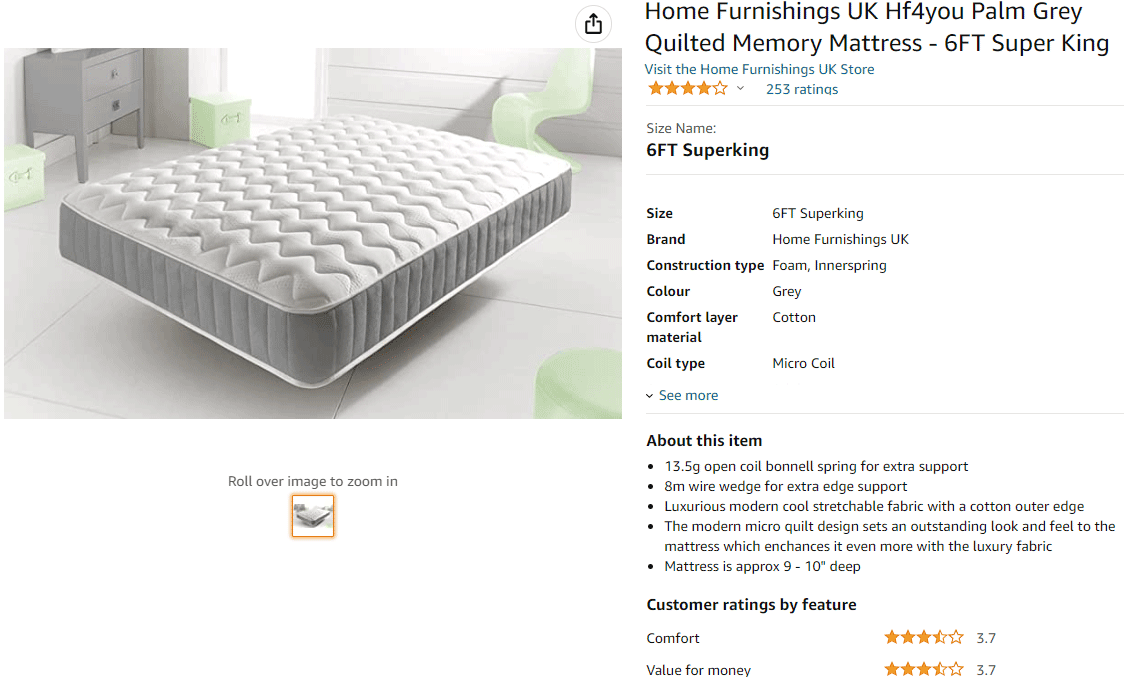
I first started selling this product in 2021. As you can see, this item has already received a good amount of reviews and positive feedback on the listing. Below, you can see a breakdown of its sales over this period.
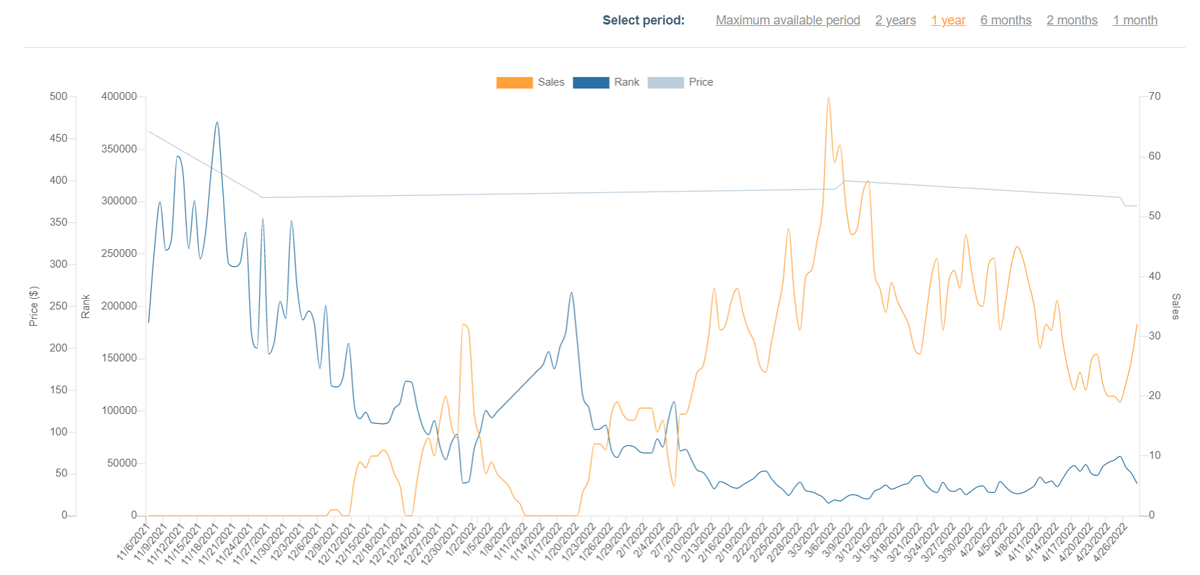
The total sales for this product increased almost tenfold in the course of a year. This growth was accomplished because the product quickly moved up the rankings for several keywords.
I was able to get this product to rank for important search terms because of the work I did using an Amazon keyword research tool. This specialized software helped me find keywords while also showing me how often different keywords are searched. I used this information to know how to best set up my listings and product selection to maximize the number of visitors that land on my products.
Below, I will walk you through the exact process that I follow when I perform keyword research, using one of my live products as an example.
When you want to start selling a product on Amazon, you need to begin your research by determining how popular the product is. There are several ways to do this. Let's take a look at how to do Amazon keyword research using a few different strategies.
The simplest way to look for keywords on Amazon is the autocomplete suggestions on the marketplace website. When you start to enter a search into the search field, Amazon will pull up a list of keywords that include what you’ve typed into the field. Below is an example of a search for the phrase “mattress”. In it, you can see modifiers for all sorts of specific items including mattress covers, toppers, and protectors.
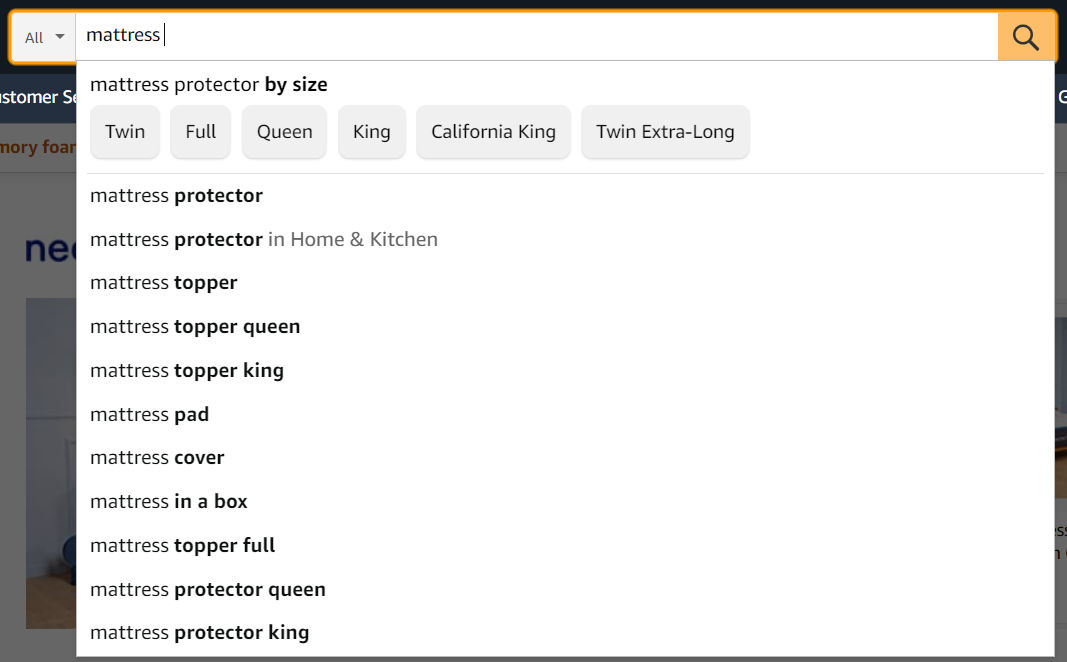
This method will give you a starting point for uncovering new keyword ideas, but it will not provide data or insights into the demand for the terms. For this, you’ll need a dedicated Amazon keyword research tool.
After you get your initial set of keyword ideas, the next step in your keyword research is to check the monthly search volume for your target terms. This will give you an idea of the demand for a particular type of product. It will also help you forecast how many sales you can expect to get if you were to rank for the keyword.
For my keyword research, I use the AMZScout Keyword Search tool. Below is how you can use the tool to check a keyword’s monthly search volume:
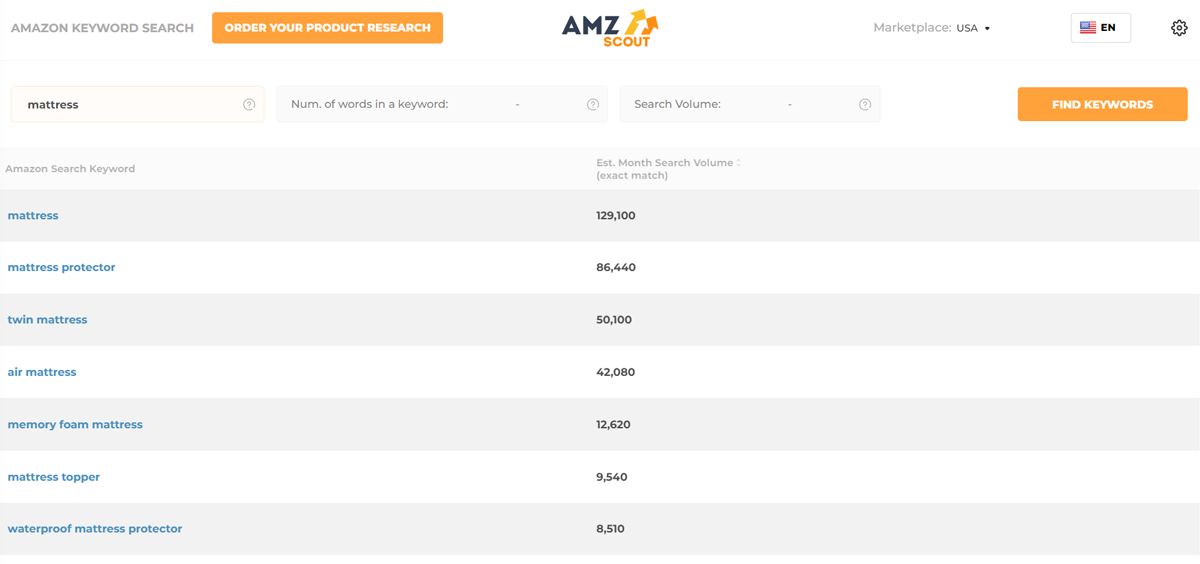
In this image, you can see my research for the seed phrase “mattress”. The results provide some interesting terms worth analyzing further. For example, the term “memory foam mattress” has a good search volume and could make for a potential niche item.
The keyword data provided by Keyword Search gives you an understanding of a product’s popularity. Items with higher sales naturally tend to have a higher search volume. In addition to assessing demand, you can also use the results to narrow down product ideas.
AMZScout's Reverse ASIN Lookup feature is a tool for finding the ranking keywords for any listing on Amazon. It is incredibly useful for conducting fast keyword research as you can enter a top-performing competitor product to quickly see all the relevant terms that it ranks for. Here is how to use the Reverse ASIN Lookup tool:
Below is an example of a reverse ASIN lookup for a memory foam mattress that I discovered in my earlier research. In the results, there are a variety of keywords with decent search volume that the product ranks for.
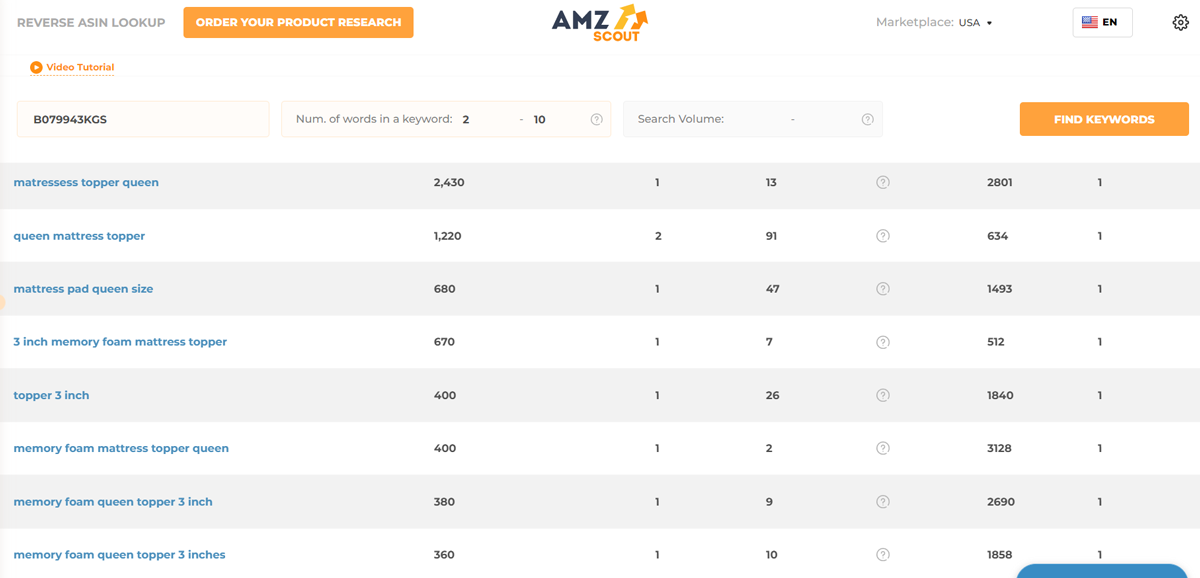
Next to each keyword, you’ll see its monthly search volume along with some other helpful metrics:
To use the search terms discovered with the Reverse Lookup tool, I like to export the keywords to a .csv file. I typically repeat this process with other ASINs and compile my research to create one comprehensive list of potential keywords.
As you build a list of master keywords, you’ll need to go through the list to determine which terms have the best potential and which should be prioritized. For this, I recommend segmenting the search terms into the following categories:
After you determine the main keywords to target, you’ll then need to decide how to use them. This is an important step if you hope to successfully rank for the terms.
Amazon ranks products based on how effectively it believes they will sell. The marketplace wants to sell as many products as possible and will thus rank the products that best match the searcher’s intent for each query.
To signal that your products are a good match for what shoppers are looking for, you need to add your target keywords throughout your listings. Here is where you’ll want to add your keywords:
In addition to adding your keywords to your listings, you’ll also want to use them in your PPC campaigns. When you go to create a paid ad campaign, Amazon will let you select the search terms to target with your ads. By adding your target keywords, you can ensure that your products appear on the results pages for those searches.
You’ll need to pay each time someone clicks one of your Sponsored Products, but this is an effective way to get targeted visitors to your listings while you wait to rank organically for the keywords.
After you launch your product and optimize your listing, it is essential to track your rankings and SEO performance. This will let you know if your strategy and optimization efforts are working. If you find that you’re not ranking well for your target terms, you can then make adjustments to your listings to help improve your rankings.
I track my products’ SEO rankings using the AMZScout Keyword Tracker. The tool is easy to set up and gives me a solid overview of where each of my items is positioned for the primary keywords that I'm targeting. You can have the software track your rankings every 1, 3, 6, 12, or 24 hours. For each search term, there are metrics for ranking page, ranking position, and a number of competing products. Plus, there is a chart showing how the ranking has changed over time.
An Amazon keyword research strategy takes time to implement. But, once you start to gain momentum, the results can be substantial. By adding my target keywords throughout my listings and advertisements, I’ve been able to get my products to appear at the top of search results for many key queries. This increased exposure has directly led to an increase in sales across my collection.
To give you an idea of how SEO success can scale over time, here are my sales numbers over the past few years:
As you can see, our sales have progressively increased, more than doubling over the past year. Our goal is to reach 10,000 orders per year, which we are close to achieving. To fulfill this objective, we will continue to look for relevant keywords and optimize our listings to drive more organic visitors to our products.
Keyword research is essential to selling successfully on Amazon. Once you know the best keywords to target, you can make sure that your listings are optimized to bring in the most traffic. If you want to make the process easier, I highly recommend using specialized Amazon research tools. Doing so will provide you with valuable search data. Plus, you can easily track your rankings to ensure you’re getting the desired results.
Originally published on May 25, 2022, updated March 11, 2024
This post is accurate as of the date of publication. Some features and information may have changed due to product updates or Amazon policy changes.
These Stories on Amazon
14321 Winter Breeze Drive
Suite 121 Midlothian, VA 23113
Call us: 800-757-6840





Copyright© 2007-2025 eComEngine, LLC. All Rights Reserved. eComEngine®, FeedbackFive®, RestockPro®, and SellerPulse® are trademarks or registered trademarks of eComEngine, LLC. Amazon's trademark is used under license from Amazon.com, Inc. or its affiliates.
No Comments Yet
Let us know what you think